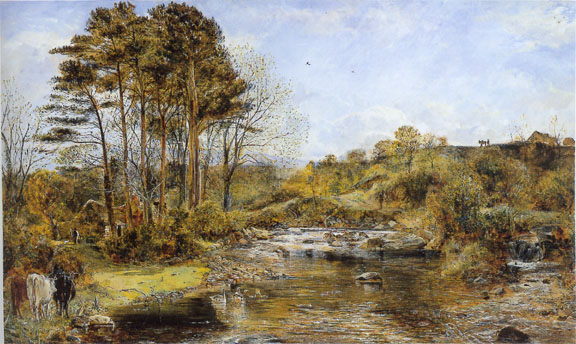
Spring Morning by William J. C. Bond. Signed and dated 1856. Oil on board: 12 x 20 inches, 30.5 x 51 centimetres. Signed and dated 1863; signed, inscribed and dated on the reverse "Morning in Spring WJJC Bond, Glan Helen Carnarvon, May 1863," and in addition on an exhibition label on the frame no. 2 Spring Morning W.J.J.C Bond 14 King St Liverpool.
Commentary by Sally Burgess
This Welsh landscape, which is arguably Bond's Pre-Raphaelite masterpiece, dates from the end of the period when Liverpool School painting was dominated by Pre-Raphaelite influence. This can be seen in Bond's use of pure glazes over a white ground and also in his attention to the minutiae of his subject. On the far bank of Glan Helen, a fisherman, his rod bowed and his line taut, hoists a gleaming salmon from the rippling river below. Bond has minutely scratched in the perfect curve of the angler's line. H. C. Marillier notes such detail as a characteristic of Bond's work: even in many complete sketches, as in a little landscape of 1856 belonging to Mr George Rae, the tendency to high elaboration may traced in the texture of some Scotch firs.
Willam Joseph J. C. Bond was from the first strongly influenced Turner and his work is often painted entirely from nature. This he felt harmonious with artistic tradition and also those other Pre-Raphaelite painters such as William Holman Hunt In Spring Morning, the placing of the main elements, utilising a strong upright bias with the trees to the left, reveals compositional gambit that Turner often used.
Bond, the youngest member of The Liverpool School, and the only one still alive when Marillier published his book on the Liverpool Academy in 1904, was known, both to his friends and the viewing public, as 'Alphabet Bond', having been encumbered by over-zealous parents with the burdensome Christian names: William Joseph Julius Caesar.
References
Nahum, Peter, and Sally Burgess. Pre-Raphaelite-Symbolist-Visionary. London: Peter Nahum at Leicester Galleries. Catalogue number 28.
Peter Nahum Ltd, London has most generously given its permission to use in the Victorian Web information, images, and text from its catalogues, and this generosity has led to the creation of hundreds of the site's most valuable documents on painting, drawing, and sculpture. The copyright on text and images from their catalogues remains, of course, with Peter Nahum Ltd.
Readers should consult the website of Peter Nahum at the Leicester Galleries to obtain information about recent exhibitions and to order their catalogues. [GPL]
Last modified 6 December 2004